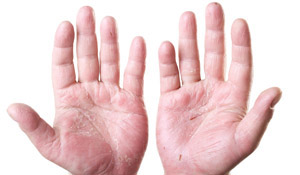
Eczema, a red rash that can appear all over the body and ranges from mildly to agonizingly itchy, is a problem for approximately 30 million people in this country. Usually diagnosed in childhood, eczema often lessens in severity as a person ages—but not always. It typically strikes on parts of the body that bend, such as the elbows, inner knees, ankles, and wrists, but it can also be found on the neck, scalp, torso, and outer limbs.
Atopic dermatitis, as eczema is also called, tends to flare for two related reasons. One is that there is a breakdown of the skin barrier, or the top layer of the skin, which protects your body from the elements as well as from chemicals and harmful microbes (microorganisms such as germs). This skin barrier is made up of proteins that literally hold it together. When these proteins don't function optimally, a person will experience irritation, rash, and itch. This leads to the second problem: Scratching the spots that itch creates new inflammation (redness and swelling) and prolongs inflammation that's already present. This is known as the itch-scratch cycle.
How to Treat Eczema
The best way to fight eczema is to stick with tried-and-true therapies, such as:
1. Keep the skin moist. This can help keep the skin barrier intact, says Craig Kraffert, MD, a dermatologist with Redding Derm in Redding, California. To help prevent drying of the skin, which can lead to eczema outbreaks, follow these steps:
- Shower in lukewarm (not hot) water, using the mildest soap you can find. Afterwards, gently pat yourself dry.
- Every day, liberally apply a good moisturizer within a few minutes of showering.
- On cold or dry days, run a humidifier in your home.
2. If lifestyle remedies aren't helping, try a prescription medication to tamp down the inflammation. Kraffert suggests tacrolimus ointment, which keeps the immune system from manufacturing chemicals that "may cause eczema," according to Medline Plus. Topical steroids may be used if the flare is severe, but tacrolimus ointment is safer, due to steroids’ potential side effects.
If you do experience itching and irritation, it's crucial to refrain from scratching, as this will only “fuel the fire,” so to speak. If you can't help yourself, try keeping your nails short so you don't break the skin. That will only prolong the flare.
The Future of Eczema Treatment
Although no new prescription drugs for eczema have entered the market in recent years, promising developments are on the horizon: "Armed with an understanding of the two main causes of eczema—skin barrier breakdown and inflammation generated by the immune system—universities and pharmaceutical companies are applying the most advanced research techniques to the study of eczema in hopes of developing breakthrough medications for future generations," declares Kraffert.
Reviewed by Craig Kraffert, MD, Redding, CA.
Sources
Craig Kraffert, MD, Redding Derm, Redding, CA. Email exchange with source on June 10, 2014.
National Eczema Association. "Eczema." Accessed on June 13, 2014.
"Tacrolimus Topical." MedlinePlus. Page last reviewed September 1, 2010.





